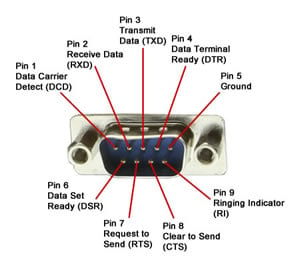RS-232 Serial Signal Differences
RS-232 Signal
On the technical side of the differences, RS232 is a single-ended signal with a specification that allows for data transmission from one transmitter to one receiver at a fairly slow data rate of up to 20K bits/second over short distances of up to 50Ft. using a maximum data rate. RS232 signals are represented by voltage levels with respect to a system power / logic ground. The “idle” state has the signal level negative with respect to common (signal ground in chart above), and the “active” state has the signal level positive with respect to common.
| Pin | Signal | Signal Name | DTE (PC) |
| 1 | DCD | Data Carrier Detection | IN |
| 2 | RXD | Receipt of Data | IN |
| 3 | TXD | Transmit Data | OUT |
| 4 | DTR | Data Terminal Ready | OUT |
| 5 | GND | Signal Ground | - |
| 6 | DSR | Data Set Ready | IN |
| 7 | RTS | Request to Send | OUT |
| 8 | CTS | Clear to Send | IN |
| 9 | RI | Ring Indicator | IN |

RS-422 Signal
RS-422 compensates in its wiring compared to RS-232 that doesn’t interpret well at higher data rates, or, long distance communication. RS-422 creates a “differential data transmission” or balanced differential signal. Using differential signals can help invalidate the effects of ground shifts and induced noise signals. These signals can sometimes appear as common mode voltages on a network; RS-422 recognizes this noise and produces a much clearer and accurate signal.
Designed for 100Kbps, RS-422 differential data transmission is designed for transmitting at distances of up to 4000 Ft. RS-422 is also designated for multi-drop “party-line” communication applications where there is only one connected driver and transmits on a “bus” of up to 10 receivers.
RS-485 Signal
RS-485 offers configuration options for local networks and multi-drop communication links. The RS-485 signal is a two wire system (twisted pair) that is either a straight or twisted pair wiring construction with a maximum of 32 transmitters and receivers can be operated. RS-485 also keeps the 100Kbps over a length of 4000 ft. transmission rate that the RS-422 specification does. RS-485 signal adapters are basically a go between from the converters to the terminal or PC using RS-485 signal levels, in other words, the format, speed, and protocol of the data during transmission is not governed by RS-485.
